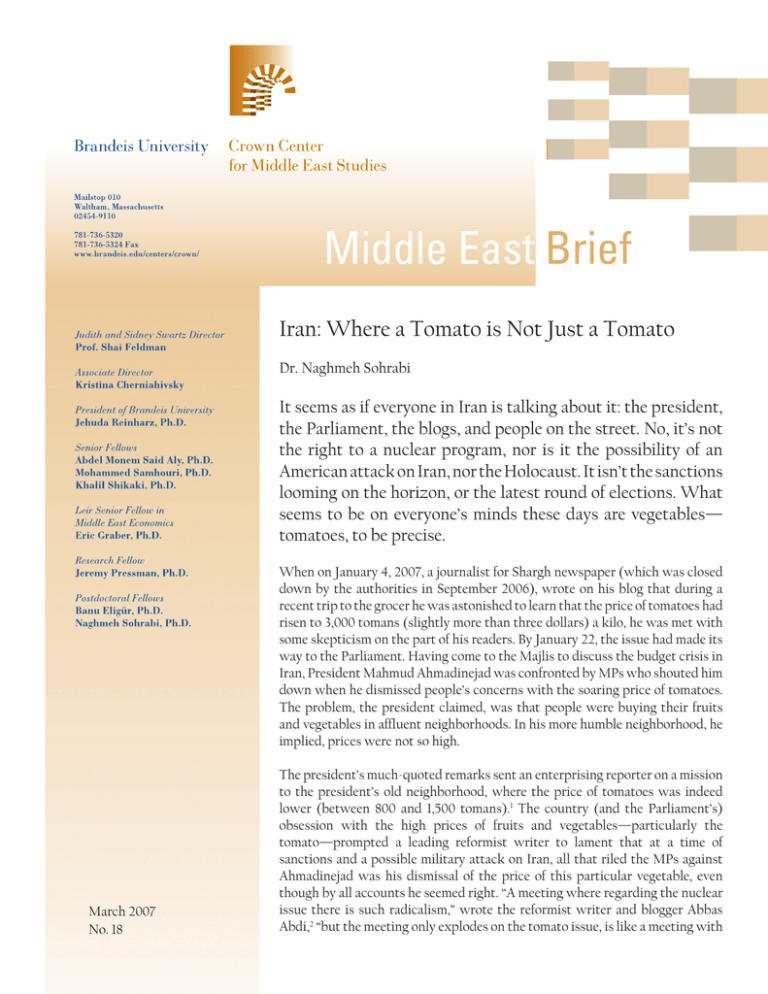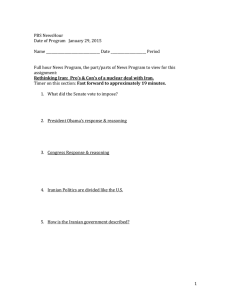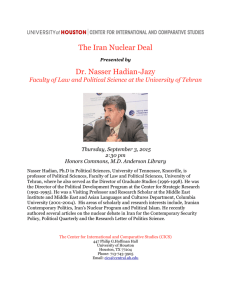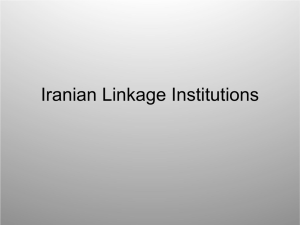Iran: Where a Tomato is Not Just a Tomato
advertisement

Iran: Where a Tomato is Not Just a Tomato Dr. Naghmeh Sohrabi It seems as if everyone in Iran is talking about it: the president, the Parliament, the blogs, and people on the street. No, it’s not the right to a nuclear program, nor is it the possibility of an American attack on Iran, nor the Holocaust. It isn’t the sanctions looming on the horizon, or the latest round of elections. What seems to be on everyone’s minds these days are vegetables— tomatoes, to be precise. When on January 4, 2007, a journalist for Shargh newspaper (which was closed down by the authorities in September 2006), wrote on his blog that during a recent trip to the grocer he was astonished to learn that the price of tomatoes had risen to 3,000 tomans (slightly more than three dollars) a kilo, he was met with some skepticism on the part of his readers. By January 22, the issue had made its way to the Parliament. Having come to the Majlis to discuss the budget crisis in Iran, President Mahmud Ahmadinejad was confronted by MPs who shouted him down when he dismissed people’s concerns with the soaring price of tomatoes. The problem, the president claimed, was that people were buying their fruits and vegetables in affluent neighborhoods. In his more humble neighborhood, he implied, prices were not so high. March 2007 No. 18 The president’s much-quoted remarks sent an enterprising reporter on a mission to the president’s old neighborhood, where the price of tomatoes was indeed lower (between 800 and 1,500 tomans).1 The country (and the Parliament’s) obsession with the high prices of fruits and vegetables—particularly the tomato—prompted a leading reformist writer to lament that at a time of sanctions and a possible military attack on Iran, all that riled the MPs against Ahmadinejad was his dismissal of the price of this particular vegetable, even though by all accounts he seemed right. “A meeting where regarding the nuclear issue there is such radicalism,” wrote the reformist writer and blogger Abbas Abdi,2 “but the meeting only explodes on the tomato issue, is like a meeting with war generals where there is much sloganeering about resisting the enemy, but then the popping of a red balloon scares everybody.”3 At first glance, Abdi’s point regarding the triviality of the price of a vegetable in light of the larger problems facing Iran, both internally and externally, seems valid. Yet what I would like to suggest in this Brief is that the tomato debates, so to speak, work on two significant levels. First, they reflect the culmination of a series of events in the past year that have challenged the sanctity of the revolutionary rhetoric in the Islamic Republic, personified in the figure of Ahmadinejad. Second, and related to that, the legitimate griping over the high prices of everyday goods, centered on the price of tomatoes, has become the public language with which to express the political and social discontent that has been brewing in Iran over the past year and a half. For the purposes of this Brief, I would like to highlight three events in December 2006 and January 2007 that have made this challenge to Ahmadinejad’s presidency possible: the results of the December 2006 Assembly of Experts and City Council elections, two op-ed pieces in conservative newspapers that criticized the president’s sloganeering, and the January two-hour television interview that confronted Ahmadinejad with respect to both his internal and external policies. That the tomato debates have arisen within these events’ time frame is, I maintain, no coincidence. The Elections of December 2006 Naghmeh Sohrabi holds a PhD in history and Middle East studies from Harvard University and is a postdoctoral fellow at the Crown Center for Middle East Studies. The opinions and findings expressed in this essay are those of the author exclusively, and do not reflect the official positions or policies of the Crown Center for Middle East Studies or Brandeis University. The results of the December 2006 elections have been widely reported in the press. Most of the analysis centered on the supposed defeat of the Ahmadinejad faction, with headlines such as “Iran: Election Results Show Anti-Ahmadinejad Vote”4 and “Iran: Election Backlash against Ahmadinejad.”5 Such coverage concentrated on the high number of votes won by Ahmadinejad’s 2005 presidential rival, Hashemi Rafsanjani, in the Assembly of Experts elections (nearly half a million more votes than the second-place finisher, Muhammad Imami Kashani).6 Additionally, in the closely watched Tehran City Council elections, the reformist camp sent four candidates to the council compared with only two sent by the oddly named “Scent of Good Service” faction, which is closely aligned with the president. Less reported was the significant number of women elected to the city councils. In addition to the president’s sister, Parvin Ahmadinejad, who won a seat on the Tehran City Council, more than 40 women were elected to seats. Among these were Mehrnoush Najafi, lawyer and blogger from the Northwest city of Hamadan, and Fatemeh Houshmand, the 25-year-old architecture student who won the largest number of votes in the Southwest city of Shiraz.7 The widespread belief that the election results point to a general discontent with Ahmadinejad’s policies stems from a particular understanding of the role of elections and voting in the Islamic Republic. From this perspective, a vote is rarely seen by outside analysts as a vote for a particular candidate, but rather as one against the status quo. This reading of Iranian election results stems from the nature of Iranian elections, whereby, on the one hand, candidates are vetted beforehand by the Guardian Council; yet voters do have the freedom to choose from among the selected candidates with very little interference from the state. The duality of the system, coupled with the fact that beginning in 1997, Iranian elections have undoubtedly elevated candidates who were not necessarily aligned with figures such as the Supreme Leader—neither Mohammad Khatami nor Mahmud Ahmadinejad were officially sanctioned candidates—has made these elections resistant to easy categories of analysis, such as democratic versus autocratic. As a result, commentators on Iran have generally presented voting in Iran as instrumentalist—that is, as merely a tool for validating or rejecting the system.8 canvas on which the cracks in the nonreformist camps were displayed for all to see. Yet in his astute analysis of the 2006 elections, Abbas Abdi notes that the results of the elections stemmed more from voter familiarity with particular candidates than from rejection of various political factions’ platforms. From this perspective, the failure of the Ahmadinejad platform to achieve a majority of seats was a result of both the lack of name recognition on the part of many of its candidates (both of the Ahmadinejad-affiliated candidates who won seats in Tehran were well-known figures) and of the faction’s late entry into the elections as a unified list. This, Abdi suggests, does not mean that the current presidential policies have been successful—only that the elections themselves were not indicative of that failure.9 Several days after the election, on December 23, the UN Security Council passed a resolution calling for sanctions against Iran on account of its refusal to suspend uranium enrichment.12 The Iranian response was unsurprisingly defiant, as chief nuclear negotiator Ali Larijani announced that Iran would continue with its nuclear program.13 But the lasting effect of the 2006 elections has little to do with the results themselves and more with the ways in which the polity came to understand the results. For the reformists who had fallen into a post-2005 depression, the December elections became a rallying cry for a new type of politics. Starting in the spring of 2006, reformist camps had begun talking of an “alliance” platform as a way of creating a unified list for the December elections. And although the election results did not necessarily reflect the victory of that list in its entirety, the resulting widespread presence of reformist members on city councils throughout the country was read by both reformists and their opposition as attesting to the success of this strategy. As a result, the “Scent of Good Service” faction has recently begun talking of creating an alliance with various political groups close to the government in advance of the next round of parliamentary elections.10 The 2006 elections also brought to the surface the rift between the various conservative camps, to the extent that in the weeks leading up to the elections, stories about the fighting between the traditional conservatives—as embodied by the mayor of Tehran, Mohammad Qalibaf (who was also a rival presidential candidate in 2005)—and the new conservatives, headed by the president, began appearing. For example, newspapers reported that in light of the increase in egg prices, the government (read: Ahmadinejad) attempted to bring truckloads of eggs to Tehran’s fruit and vegetable distribution centers, only to be prevented from unloading them by the city (read: Qalibaf); the city claimed that the trucks were obstructing traffic and confiscated them.11 Thus the electoral victory of the Qalibaf faction, while still a conservative victory, was seen among the conservatives themselves as a defeat for Ahmadinejad and his policies. The December elections became a public The Events of January 2007 By January, opposition to Ahmadinejad’s policies began to snowball in an unprecedented way. Much of the opposition was targeted at the administration’s economic policies. For example, in a continuation of the Parliament’s battles with the president’s budget proposal, more than half of the parliamentarians wrote an open letter criticizing the president’s delays in presenting his budget and “a perceived over-reliance on oil revenues” in his proposal.14 But the attacks on the government’s economic policy were nothing new. Since the beginning of his presidential term, Ahmadinejad had been under criticism—albeit less vocal and widespread criticism—for his unrealistic economic programs.15 What was new was the confidence with which the reformist camp began to criticize the president’s foreign policy, specifically in regards to nuclear development—and, more importantly, the addition of conservative voices to the growing chorus. For example, throughout the month of December, a staterun radio station had “been conducting an open debate for the past month about whether Iran should change its tough stance on its nuclear program.”16 Additionally, after the passage of the UN resolution in December, a growing number of reformists, including Hossein Moussavian (a member of the Iranian nuclear negotiating team under Khatami), criticized the current nuclear policy and called for a return to negotiations.17 This “melting of the untouched ice block that is criticism of the president and the government”18 reached its peak (and officially spread to the conservative camp) with back-to-back op-ed pieces in two conservative newspapers: Jomhouri Islami and Hamshahri. On January 9, 2007, Jomhouri Islami (which is believed to be aligned with the Supreme Leader, Ayatollah Ali Khamenei19) published a scathing opinion piece entitled “A Message for the Friends of the Revolution.” The piece begins by criticizing those who in the aftermath of the resolution had called for a return to President Khatami’s nuclear policy and even the suspension of enrichment. Do these people not consider the fact that these types of criticism will make “strangers” think that by “putting out a resolution they can make Iran retreat or at the least create dissent?”20 More intriguingly, however, the piece continues by saying that “on the other hand, we have a few words for the honorable president Mr. Ahmadinejad.” Speaking of Ahmadinejad’s constant reference to the nuclear program in all his speeches throughout the country (in Iran, variations on the slogan “Atomic energy is our inalienable right” serve as the punch line for many jokes), the op-ed harshly states: “Anything that is repeated more than necessary, instead of strengthening the will, only leads to dismissal. The fact that in every speech in every city you feel you must talk about nuclear energy does not seem to be the right strategy.” Criticizing the president’s flippant attitude toward the UN resolution, the piece goes on to advise that “people must feel that the president is attempting to solve the problem realistically. That whether there is a resolution or not is of no concern to you does not seem to be the correct way to go about things.” The second op-ed, in the popular newspaper Hamshahri (which is run by Entezami, a long-time acquaintance of nuclear negotiator Ali Larijani), focused exclusively on the president’s nuclear policy. Less direct than the piece in Jomhouri Islami, the op-ed nonetheless called on the country’s administrators to choose an “effective strategy” in dealing with Iran’s nuclear diplomacy before the cost became too high for the country.21 Aside from the obvious significance of these opinion pieces as critiques of the Iranian president, their publication sanctioned open discussion of Iran’s nuclear policy, and of its stance vis-à-vis the international community. Hamshahri acknowledged this when it observed that although the issue of Iran’s nuclear program had not been discussed much “in the media,” the current situation demanded a new strategy. The January 24th live television interview with the president was perhaps even more telling. In the interview, Ahmadinejad was confronted by a barrage of questions ranging from the issue of his much-delayed budget proposal relying too heavily on oil revenues (“We have a Five Year Plan on the basis of which we determine the yearly budget, and we organize the Five Year Plan based on the Twenty Year Prospective” was his response) to the high prices of fruit and housing (“Tomato is not a fruit.”). The president was asked to explain his “emotional and slogan-driven diplomacy” (“I feel the need to say something about ‘emotions’ here; emotions have gotten the short shrift”) as well as his administration’s nuclear policy (“On the nuclear issue, our position is very clear. We fully comply with the agency’s regulations.”). When the interviewer finally asked, “So you’re actually not worried about the future of the country?” he responded: “I’m not worried about the future of this country. Why should I be worried?”22 What stood out in the interview was not only the range of issues haunting the administration (of which international problems seemed to constitute a small though significant portion), nor the president’s responses to the questions, but rather the questions themselves. The fact that this probing interview was conducted on state-run television (as opposed to, say, in a reformist-leaning newspaper) reflected the degree of the nation’s uneasiness and the depths of anxiety regarding the direction in which the country was heading. The taboo of criticizing the president in public was broken—not by a reformist press but on conservative, state-run television. The Long-Term Impact In the short term, the practical impact of these developments in the context of the recent escalation of the conflict between Iran and the United States, especially on the Iraqi front, is unclear: One can make the argument that Iran’s internal instability will only further entrench Ahmadinejad in his defiance, or one could argue that it is only a matter of time before the powers that be rein in the president and possibly diffuse the situation. But in the long term, the recent events within Iran have had the effect of eroding any lingering belief that the 1979 revolution’s rhetoric and slogans can work effectively as a guiding policy for the Islamic Republic of Iran. This is in itself an unexpected and significant development. Regardless of the reasons behind his election, Ahmadinejad exemplified a return to the early ideals of the revolution—with its strident antiAmerican and isolationist foreign policy and its austere domestic policy (including a more fully statist economic policy)—which had been “sullied” during Khatami’s eightyear presidency. But the Iran of today is not the Iran of 1979. As the country’s rulers have observed, the option of closing the country’s borders to the outside world and operating on a rhetoric of self-sacrifice (as Iran did during the Iran-Iraq war) no longer exists. Not only has the geopolitical situation in the region changed, but more importantly, the nature of the Iranian state has changed, along with its ruling apparatus. One indicator of this irreversible change has been the invocation of the term nukhbeh (“elite”) in the general criticism of the Ahmadinejad administration. Near the end of the January 24th televised interview, the interviewer asks Ahmadinejad: “Some people say the government behaves rashly and excitedly and doesn’t use the elite.” Ahmadinejad responds: “First of all, I am a university man myself and an elite. This government is better educated than any previous government. The range of our family friends is also elite. . . . Some people imply that this government doesn’t consult with the elite. They just say this because the government doesn’t do what they want.”23 This somewhat strange exchange encompasses both the degree to which the revolutionary nature of the Islamic Republic has changed and the acceptance of the inevitability of this change by those in power today. The 1979 revolution, buoyed by anti-Western and populist rhetoric, ushered in the Cultural Revolution, which aimed to purge universities of “leftist, un-Islamic, or independent faculty.”24 Hand in hand with these purges was the replacement of governmental employees (on all levels) with often less qualified but more ideologically appropriate figures. The lore of Iran in the 1980s is replete with stories of incompetent people in positions of power whose only qualification was their membership in various Islamic groups or their being relatives of the martyrs of the Iran-Iraq war. In the mid-1990s, however, as revolutionary fervor slowly became diluted with Rafsanjani-era “pragmatism,” there was a return to notions of professionalism and a belief in the importance of a qualified elite holding positions of power. This itself was partly a result of the life trajectory of those who came later on to be known as reformists: active members of the 1979 revolution who came into power on the strength of their ideological convictions, and who as a result both gained experience and an education and, more importantly, underwent a rethinking of their own revolutionary past.25 If the reformists represented those who, having benefited from the fruits of the 1979 revolution, came to question both its past and its future, Ahmadinejad represented another strand of the same generation, one which saw the 1980s as the golden era of the revolution. His populism, with its emphasis on social equality; his impractical statist economic policy; and his reinjection of a strong anti-American, anti-Israel rhetoric into Iran’s foreign policy are (often pale) imitations of Iran in its early revolutionary days, which sought to disseminate its revolutionary rhetoric to the rest of the Muslim world. From this perspective, Ahmadinejad’s proclamations regarding Israel and the Holocaust (which first began as a direct quotation from Ayatollah Khomeini26) have been read as his reaching out to the Arab or Muslim street as a way of returning to early revolutionary ideals. Yet as the developments outlined in this Brief, reflecting a larger and more sustained critique of the government, make clear, the system has come to the understanding that there is no return to a revolutionary and slogan-based form of governance. What now matters in Iran is not an ideal of an Islamic empire but the reality of the Iranian state. The unity with which Iran was ruled in the 1980s and early 1990s was sundered with the election of Khatami in 1997, only to have now splintered to such a degree that the terms “conservative” and “reformist” have all but lost their meaning. And while recent developments within Iran seem to indicate that this reality is slowly being absorbed into the political system, it remains to be seen to what degree the international community can grasp and utilize it in its assessments of Iran’s place on the global stage. As for the question of why, in the current situation, the tomato has trumped not only all other vegetables but also questions of nuclear policy, sanctions, and the conflict with the United States, the answer, one hopes, is now clear: Sometimes a tomato is not just a tomato. Endnotes 1 http://www.aftabnews.ir/vdcjmveuqiemi.html. The lower tomato prices were also confirmed to me in private communications.* 2 Abdi is referring to Ahmadinejad’s comment that no amount of UN resolutions will deter Iran from its nuclear policy. See http://www.ayande.ir/1385/11/post_146.html#more.* 3 http://www.ayande.ir/1385/11/post_146.html#more.* 4 http://www.rferl.org/featuresarticle/2006/12/a2b68f48-0826-40eca196-5df742e49616.html.* 5 http://www.worldpress.org/Mideast/2614.cfm.* 6 http://www.isna.ir/Main/NewsView.aspx?ID=News-846591&Lang=P.* 7 Shahram Rafizadeh, “Impressive Performance of Women in City Council Elections,” Rooz, January 7, 2007; available at http://www.roozonline.com/english/archives/2007/01/001171. php.* 8 This understanding of the role of voting in the Islamic Republic has also fed into the most recent debates regarding the futility or usefulness of wholesale boycotts of elections in Iran. 9 http://www.ayande.ir/1385/10/_1_3.html#more.* 10 http://www.aftabnews.ir/vdciqyat1vaqw.html.* 11 Quoted from Iran newspaper on Akbar Muntajibi’s site. See http://akmont.blogfa. com/8509.aspx.* 12 Associated Press, “Security Council Approves Sanctions on Iran over Nuclear Program,” USA Today, December 23, 2006; available at http://www.usatoday.com/news/world/200612-23-iran_x.htm.* 13 Ibid. 14 “Iran: President Ahmadinejad Comes under Fire,” Radio Free Europe/Radio Liberty, January 19, 2007; available at http://www.rferl.org/featuresarticle/2007/01/016f98ee-5e4a4192-992b-69053afd12d7.html.* 15 For an analysis of the past criticism, see Naghmeh Sohrabi, “Conservatives, Neoconservatives and Reformists: Iran after the Election of Mahmud Ahmadinejad,” Crown Center Middle East Brief no. 4, April 2006.* 16 See Nazila Fathi, “Tehran Radio Lets Critics Vent over Iran’s Nuclear Plans,” New York Times, January 1, 2007.* 17 “Iran: Former Officials, Reformists Criticize Nuclear Policy,” Radio Free Europe/Radio Liberty, January 10, 2007; available at http://www.rferl.org/featuresarticle/2007/01/ c1ddb942-8e8d-4b7e-aa41-5d7139c27a68.html.* 18 http://alpr.30morgh.org/archives/005310.php.* 19 Nazila Fathi and Michael Slackman, “Iran’s President Criticized over Nuclear Issue,” New York Times, January 18, 2007; available at http://www.nytimes.com/2007/01/18/world/ middleeast/18cnd-iran.html?ex=1326776400&en=92d3775836de5ec9&ei=5088&partner=rs snyt&emc=rss.* 20 http://jomhourieslami.com/1385/13851019/13851019_jomhori_islami_01_sar_ magaleh.HTML.* 21 http://hamshahrionline.ir/News/?id=13474.* 22 Baztab newspaper, 4 bahman 1385 accessed on January 29, http://www.baztab.ir/news/58745.php.* 23 http://www.baztab.ir/news/58745.php.* 24 Ahmad Ashraf and Ali Banuazizi, “Iran’s Tortuous Path Toward ‘Islamic Liberalism,” International Journal of Politics, Culture, and Society, Vol. 15, No. 2, Winter 2001, 242. 25 There are many well-known figures who experienced this shift. The filmmaker Mohsen Makhmalbaf, for example, had, famously, never stepped into a movie theater until after the revolution, when at the age of 18 he began to work for the Islamic Propaganda Organization. His access to Iran’s film archives led him not only to a career in film but to a fundamental rethinking of his revolutionary ideals. His shaving of his beard in the early 1990s publicly proclaimed this conversion. 26 Cable News Network, “Iranian leader: Wipe out Israel,” October 27, 2005; available at http://www.cnn.com/2005/WORLD/ meast/10/26/ahmadinejad/.* * Weblinks are available in the PDF version found at www.brandeis.edu/centers/crown Iran: Where a Tomato is not Just a Tomato. Dr. Naghmeh Sohrabi Recent Middle East Briefs: Available on the Crown Center website http://www.brandeis.edu/centers/crown Abdel Monem Said Aly, “From Deterrence to Legitimacy: A Proposed Shift in U.S. Policy in the Middle East,” March 2007, No. 17. Mohammed Samhouri, “Looking Beyond the Numbers: The Palestinian Socioeconomic Crisis of 2006,” Febuary 2007, No. 16. Carol Saivetz, “Moscow’s Iranian Policies: Opportunities and Dangers,” January 2007, No. 15. Joshua Shifrinson, “The Kurds and Regional Security: An Evaluation of Developments since the Iraq War,” December 2006, No. 14. Jeremy Pressman, “The United States and the Israel-Hezbollah War,” November 2006, No. 13.






